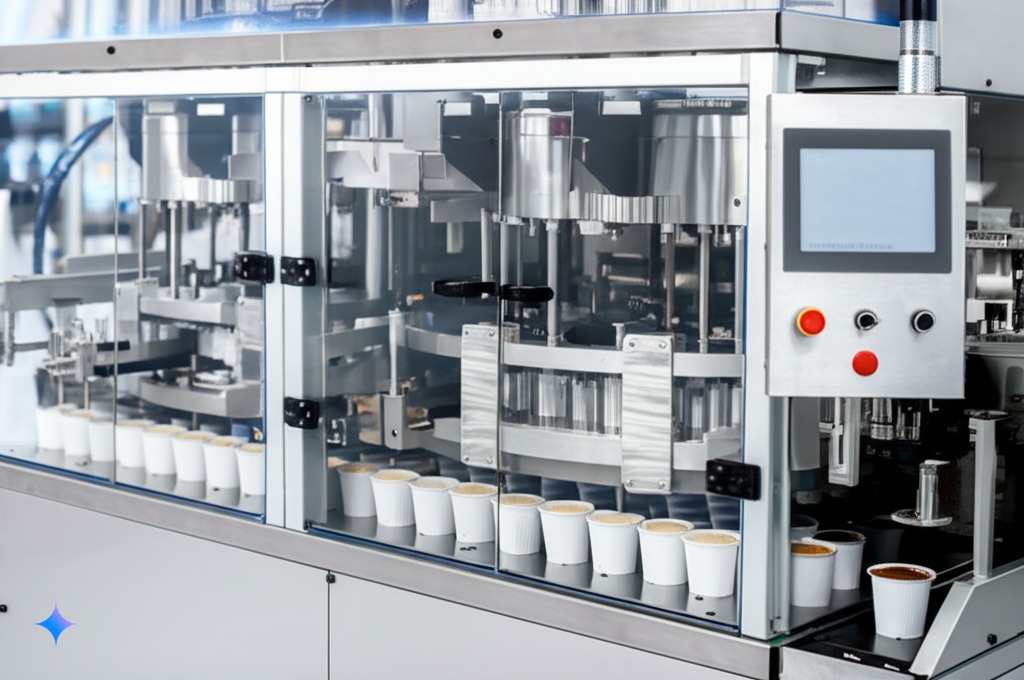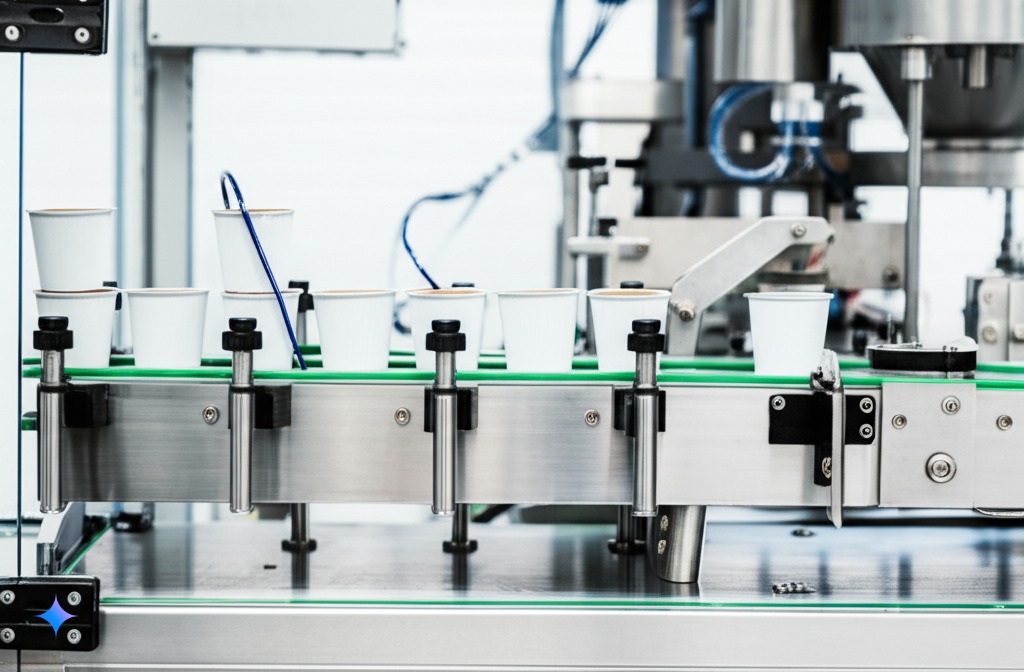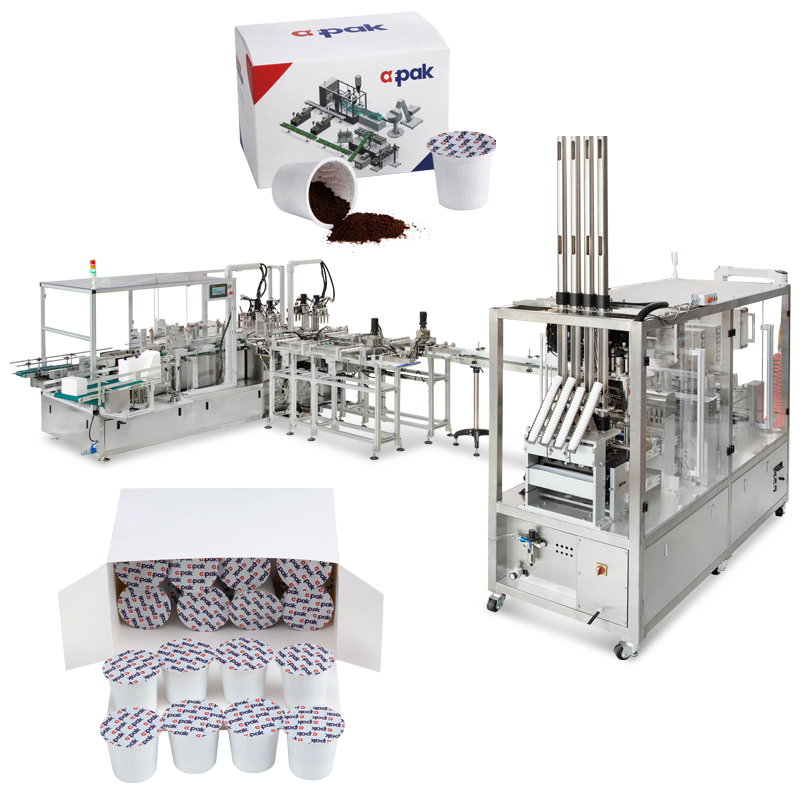Sentindo -se perdido no mundo da produção de cápsulas de café? Quer saber por onde começar? Você não está sozinho; É uma questão comum.
Uma máquina de enchimento K-Cup é uma peça de equipamento especializada projetada para preencher e selar automaticamente as cápsulas de café de serviço único, especificamente as compatíveis com os fabricantes de cerveja Keurig. Essas máquinas podem lidar com todo o processo, desde a distribuição do café até a vedação da tampa, e são padrão para o café de 8 a 13g, garantindo qualidade e frescor consistentes.

As máquinas de preenchimento K-Cup simplificam a produção de cápsula de café. Mas eles são peças complexas de equipamentos. Vamos quebrá -lo.
Para que é a máquina de enchimento da copo K usada?
Novo na produção de K-Cup e confuso sobre o que essas máquinas realmente fazem? Parece complexo, mas é importante entender a função central.
As máquinas de preenchimento K-Cup são usadas principalmente para produzir cápsulas de café para máquinas Keurig. Eles lidam com o recheio, a vedação e a descarga de nitrogênio. Você também pode adicionar recursos como pesagem e codificação.

O uso principal é, é claro, café. Mas eles são mais versáteis do que você imagina. As máquinas de preenchimento K-Cup não são apenas para café. Você também pode usá -los para leite em pó, chá em pó, matcha e outros materiais em pó. Você pode até modificar a estrutura de enchimento para lidar com produtos granulares. Essa flexibilidade é crucial. Ele abre possibilidades além do café. Pense em diferentes sabores, ou mesmo produtos focados na saúde. Considere a facilidade de limpeza também. Você não quer resíduos de café em suas cápsulas de chá.
| Material de enchimento | Adaptabilidade da máquina K-Cup | Considerações |
|---|---|---|
| Café em pó | Padrão | Tamanho da moagem, densidade |
| Leite em pó | Adaptável | Propriedades de fluxo, viscosidade |
| Chá em pó | Adaptável | Tamanho da folha, densidade |
| Pó matcha | Adaptável | Finidade, aglomeração |
| Produtos granulares | Requer modificação | Tamanho da partícula, fluxo |
Qual é o princípio de funcionamento das máquinas de preenchimento KCUP?
Lutando para visualizar como um Máquina de preenchimento K-Cup realmente funciona? O processo pode parecer mágico, mas é tudo sobre mecânica precisa.
O princípio de trabalho básico envolve várias etapas automatizadas: distribuição de copos, preenchimento com o produto (geralmente café), calçando (comprimindo) o produto, selando a parte superior com uma tampa de papel alumínio e descarregando o k-cup acabado. É um fluxo de trabalho suave e eficiente.

Pense nisso como uma linha de montagem. Primeiro, os K-Cups vazios são carregados. Eles se mudam para o posto de gasolina. Uma quantidade precisa de café (ou outro produto) é dispensada. O café é então calçado. Isso garante extração uniforme. Uma tampa de papel alumínio é colocada em cima. A tampa é selada, criando um recipiente hermético. Finalmente, o K-Cup acabado é ejetado. Muitas máquinas também liberam o K-Cup com nitrogênio. Isso remove oxigênio. Mantém o produto fresco por mais tempo. Todo o processo é controlado por um PLC (controlador lógico programável). Isso garante precisão e consistência. Sensores monitoram cada etapa.
| Etapa | Ação | Componente -chave | Propósito |
|---|---|---|---|
| Distribuição de copos | Carrega k-cups vazios na máquina | O teste | Inicia o processo de produção |
| Enchimento | Dispensa o produto no K-Cup | Servo Motor Controled Buger Filler | Medição precisa do produto |
| Tamping | Comprime o produto dentro do k-cup | Tamping Head | Garante extração uniforme durante a fabricação de cerveja |
| Vedação | Aplica e sela uma tampa de papel alumínio ao K-Cup | Cabeça de vedação | Cria um selo hermético, preserva o frescor |
| Nitrogênio nivelado | Injeta gás nitrogênio no k-cup | Sistema de descarga de nitrogênio | Remove oxigênio, estende a vida útil |
| Descarga | Ejeta o k-cup acabado da máquina | Transportador de saída | Completa o ciclo de produção |
Quais são os preços variam para as máquinas de preenchimento de K-Cup?
Preocupações orçamentárias impedindo você de investir em uma máquina de preenchimento K-Cup? O preço é um fator importante para qualquer negócio. Vejamos as opções.
Os preços das máquinas de envase K-cup variam amplamente, de cerca de US$ 10.000 a mais de US$ 500.000. Isso depende da capacidade de produção, qualidade, recursos e nível de automação. Para testes em pequena escala, existem opções semiautomáticas na faixa de US$ 1.000 a US$ 2.000.

Existe uma máquina para cada orçamento. Começando pequeno? Uma máquina semiautomática pode ser perfeita. Estes são mais baratos. Eles exigem mais trabalho manual. Mas eles são ótimos para testes ou produção de baixo volume. Pronto para aumentar a escala? Máquinas automáticas são o caminho a percorrer. Estes são mais rápidos. Eles exigem menos mão de obra. Mas eles custam mais antecipadamente. O preço também depende dos recursos. Você precisa de lavagem com nitrogênio? Pesagem? Colocação automática da tampa? Cada recurso aumenta o custo. Considere seus objetivos de longo prazo. Investir em uma máquina de maior capacidade pode valer a pena. Mesmo que você não precise disso imediatamente. Isso lhe dá espaço para crescer.
| Tipo de máquina | Faixa de preço (USD) | Capacidade de Produção (Xícaras/Hora) | Características |
|---|---|---|---|
| Semiautomático | US$ 1.000 - US$ 2.000 | Baixo (Manual) | Enchimento e selagem básicos |
| Nível básico | US$ 10.000 - US$ 50.000 | 500 - 1.000 | Enchimento e selagem automatizados em uma pista |
| Médio alcance | US$ 50.000 - US$ 100.000 | 2,000 - 12,000 | Enchedoras multicabeças de 2/4 pistas, selagem automatizada |
| Alto padrão | US$ 100.000 ou mais | 12.000+ | Mais de 6 pistas Automação avançada, alto rendimento |
Que outras máquinas para trabalhar com máquinas de preenchimento KCUP?
Pensando que uma máquina de envase K-cup é tudo que você precisa? É o núcleo, mas outros equipamentos podem aumentar a eficiência.
Além da própria máquina de envase, normalmente você precisará de um compressor de ar e um gerador de nitrogênio. Para maior produção, considere uma máquina de embalagem K-Cup para automatizar a embalagem.

A máquina de envase é o coração da operação. Mas não funciona sozinho. Um compressor de ar é essencial. Ele alimenta muitas das funções da máquina. Os sistemas pneumáticos utilizam ar comprimido. Um gerador de nitrogênio também é crucial. Ele fornece nitrogênio para lavagem. Isso mantém o produto fresco. Para operações maiores, considere equipamentos adicionais. Uma máquina de encadernação automatiza o boxe. Ele embala K-Cups cheios em caixas. Isso economiza tempo e trabalho. Um controlador de peso garante que cada K-Cup tenha o peso correto. Isso mantém o controle de qualidade. Uma impressora pode adicionar códigos de data ou outras informações. Isto é importante para a rastreabilidade. Pense em todo o seu processo. Do início ao fim. Automatize o máximo possível. Isso aumenta a eficiência. Reduz custos a longo prazo.
| Equipamento de Apoio | Função | Beneficiar |
|---|---|---|
| Compressor de ar | Fornece ar comprimido para operação da máquina | Alimenta sistemas pneumáticos |
| Gerador de nitrogênio | Fornece gás nitrogênio | Preserva o frescor, prolonga a vida útil |
| Máquina de encadernação K-Cup | Embala automaticamente K-Cups em caixas | Aumenta a eficiência da embalagem, reduz o trabalho |
| Verificador de peso | Verifica o peso de cada K-Cup | Garante qualidade consistente do produto |
| Impressora | Imprime códigos de data, números de lote, etc. | Fornece rastreabilidade e informações do produto |
Conclusão
Máquinas de envase K-cup são essenciais para uma eficiência produção de cápsulas de café. Ao compreender os diferentes componentes, você pode escolher a máquina certa para o seu negócio.
